Luang Prabang is located in north central Laos on a peninsula bounded by the Mekong River to the north and the Khan River to the east. Listed as a UNESCO World Heritage Site. Since 1995, Luang Prabang attracts tourists from international and regional markets through a combination of preserved cultural experiences and natural beauty within the province. The following article gives a brief overview of Luang Prabang, its tourism industry and recent dynamics of the local lodging market.
.jpg)
Laos Overview
Map of Laos
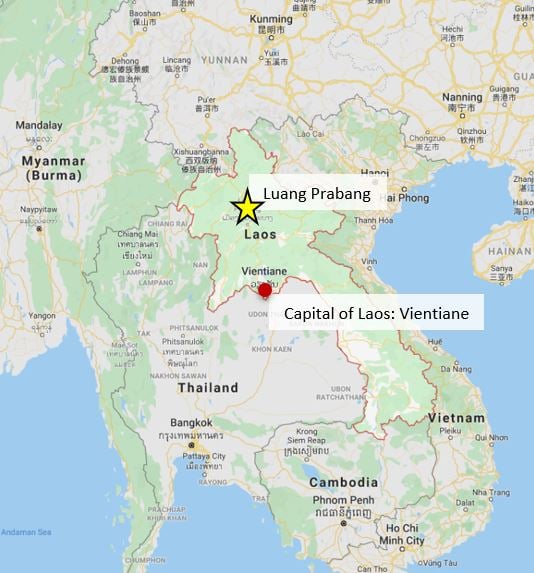 Source: Google Maps
Source: Google Maps

The Lao People's Democratic Republic is a landlocked nation in the central region of the Indochina peninsula. The country borders Thailand to the west and Vietnam to the east, Cambodia to the southwest and Burma and China to the northwest. As one of Asia’s least developed countries, the population of 7.1 million people is distributed unevenly throughout the rugged mountainous terrain. The capital city Vientiane is located on the Mekong River at the border between Laos and Thailand.
Historical and Forecast Economical Indicators - Laos


Source: Economist Intelligence Unit, December 2019
Real GDP growth for Laos has been in the region of approximately 6.5-7.6% between 2014 and 2018. GDP growth for the country is expected to grow gradually as it slowly opens up to the international and regional market with more air and road access. In 2017, total contributions by the travel and tourism sector to Laos’ GDP accounted for 13.7%, and is expected to increase further with improved infrastructure and various travel campaigns. Even though economy of Laos is showing signs of development, it is still considered as one of the least-developed countries in Asia, with current account deficit. The government relies heavily on foreign aid from international donors, notably from China to finance key infrastructure and development projects. Export should continue to gradually increase with mainly agricultural products and natural resources.
Amidst the outbreak of COVID-19, the economy of Laos is projected to contract as an effect of a global economic downturn. To control the outbreak of COVID-19 in Laos, the government enforced two months of national lockdown starting in late March that has heavily affected the tourism industry as well as retail shops and restaurants. According to the World Bank, the impact of the COVID-19 pandemic will likely to increase the fiscal deficit and unemployment rate. To reflect the expected fall in private consumption, tourist arrivals and foreign direct investment, Economist Intelligence Unit has downgraded Laos’ real GDP growth forecast for 2020 to 2.8%, from 6.5% previously. They projected that growth will rebound in 2021, to 4.6%. The economic outlook will be dependent on the duration of the global outbreak of COVID-19 and effectiveness of economic relief measures from the government for the time being.
Amidst the outbreak of COVID-19, the economy of Laos is projected to contract as an effect of a global economic downturn. To control the outbreak of COVID-19 in Laos, the government enforced two months of national lockdown starting in late March that has heavily affected the tourism industry as well as retail shops and restaurants. According to the World Bank, the impact of the COVID-19 pandemic will likely to increase the fiscal deficit and unemployment rate. To reflect the expected fall in private consumption, tourist arrivals and foreign direct investment, Economist Intelligence Unit has downgraded Laos’ real GDP growth forecast for 2020 to 2.8%, from 6.5% previously. They projected that growth will rebound in 2021, to 4.6%. The economic outlook will be dependent on the duration of the global outbreak of COVID-19 and effectiveness of economic relief measures from the government for the time being.
Historical Visitor Arrivals - Laos, 2013-2019
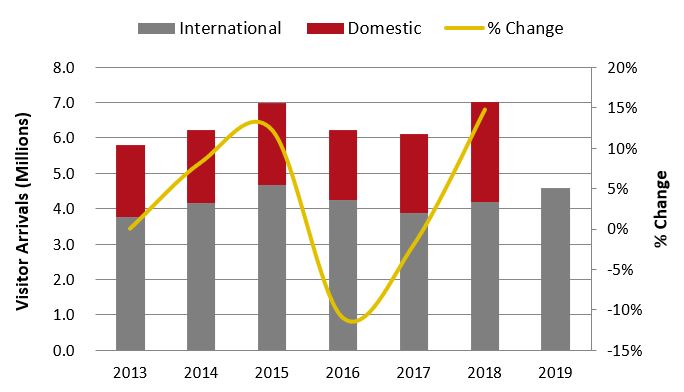
Source: Ministry of Information, Culture and Tourism, Tourism Development Department of Laos
In 2018, Laos’ visitor arrival figures performed well, gaining momentum from a rigorous tourism campaign titled 'Visit Laos Year 2018', breaking into a total of seven million tourist arrivals from domestic and international travelers. At the time of writing, domestic tourism figures for 2019 were not published. The launch of the campaign boosted travel activities from foreign travelers, which are dominated by tourists from Thailand, Vietnam and China. Laos welcomed 4.58 million international visitors in 2019, representing growth of nine percent over 2018. Grace to the success of the Visit Laos-China Year, Chinese travelers grew the fastest with a 27% increase in visitor arrivals from 2018, reaching just over one million arrivals. Other markets progressed as well with American visitor arrivals increasing by 22% while Vietnamese visitors increased by 11%.
As long-haul tourists usually visit Laos as part of a Southeast Asia tour for three to five days, many are attracted by the country’s authenticity and simplicity, as well as the beauty of its landscapes. In the southern region of Laos, the 4,000 Islands is a notable tourist destination to admire the nature and swim in the waterfalls or Mekong River. In northwestern Laos on the Thai border, visitors can experience the capital of Laos, Vientiane with various temples and monuments. Northern Laos is best known for Luang Prabang which is a UNESCO World Heritage Site for blending the local and French colonial architectural styles and cultural traditions. Luang Prabang also offers a vibrant night market, some authentic temples, and waterfall hikes outside of the city. Despite the rapid growth that Laos registered in 2019, visitor arrivals declined sharply due to the outbreak of COVID-19 and national lockdown. International borders have been closed since March. On May 18, Laos Government lifted a ban on interprovincial travel and businesses have been slowly reopening, predominantly restaurants and retail stores. At the time of writing, foreigners were still not allowed to visit Laos. As COVID-19 measures and some travel restrictions are gradually lifted, the tourism industry will heavily rely on domestic travelers to lead the reopening of hotels in the short-term.
Seasonality
Based on the seasonality trend in the last three years, a notable low season can be observed from June to September, coinciding with the rainy season alongside the highest temperature in the year. Monsoon season in Laos is characterized with downpour for few hours a day, instead of daily all-day rain. The high season tends to begin around September and lasts until February; this is generally the coolest time of the year. The country is the busiest around the winter holiday seasons and Chinese New Year. Shoulder seasons can be observed from March to May. The year-round average length of stay is recorded at approximately 3.5 days.
There has been a gradual shift in the low season from month of June in 2016 to September in 2017 and July in 2018 recording the lowest number of visitors. This is reflective of the growth in visitors from China, and the reduction in visitors from Vietnam, Europe and the Americas.
There has been a gradual shift in the low season from month of June in 2016 to September in 2017 and July in 2018 recording the lowest number of visitors. This is reflective of the growth in visitors from China, and the reduction in visitors from Vietnam, Europe and the Americas.
Infrastructure and Accessibility
Laos’ air transport network consists of 10 airports for commercial flights, of which four are international airports with paved runways. The majority of international air traffic connects to Thailand. As the China border is relatively close to Luang Prabang, many Chinese travels to Luang Prabang by car or bus. In order to boost the tourism sector, the government has proposed plans to expand existing international airports, develop a new airport and renovate six domestic airports. Due to the outbreak of COVID-19, we assume that some projects have been on hold and delayed on expected completion.
domestic airports. Due to the outbreak of COVID-19, we assume that some projects have been on hold and delayed on expected completion.
Key infrastructure improvements include the following:
Key infrastructure improvements include the following:
- Wattay International Airport: US$61 million renovation for runway expansion, facility and road upgrades at the country’s principal airport in Vientiane;
- Vientiane–Boten Railway (also commonly referred as China-Laos Railway): 414 kilometers length of railway connecting Boten on Laos’ northern border with China, through Vientiane, capital of Laos to Thanaleng, on the border with Thailand. In the north, the railway will be connected to the Chinese rail system in Mohan, through the Yuxi–Mohan railway. . The passenger train will be able to run at speeds of 160 kilometres per hour, while freight services will run at 120 kilometres per hour. Upon completion, this railway will be a link in the central route of Kunming–Singapore railway network Sponsored by the Government of China and Laos, this project is expected to create closer trade links and further stimulate the tourism industry. The railway is expected to complete construction in 2021;
- Savannakhet–Lao Bao Rail Link Project: 220 kilometers of the railway that will cover Laos from east to west and crossing the border of Vietnam into Danang port city. The project is estimated to finish in 2020.
Luang Prabang International Airport
Luang Prabang International Airport is located four kilometers from the center of Luang Prabang in northern Laos. Airlines that operate scheduled flights from Luang Prabang Airport include Bangkok Airways, Lao Airlines, Vietnam Airlines, SilkAir, Thai Smile, China Eastern Airlines, and more. As a relatively small airport, the airport has one terminal and one runway for both domestic and international flights. Lao Airlines have recently announced new direct flights from Japan to Laos with regularly scheduled flights from Kumamoto in Kyushu to Luang Prabang and Vientiane. An Airbus A320 aircraft with 142 seats will be used for two round trip services a week to each of Vientiane and Luang Prabang. As direct flights between Luang Prabang and Japan will start in 2020, it is expected to induce demand into the city with a higher visitor arrival of Japanese tourists.
Passenger Movements at Luang Prabang International Airport, 2014-2018
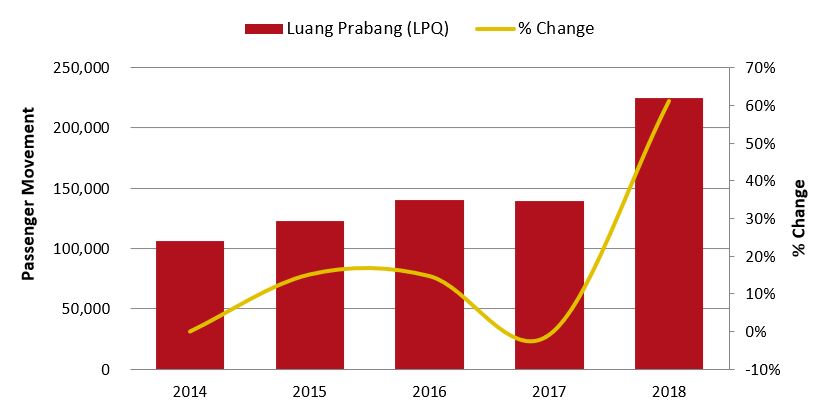
Source: Ministry of Information, Culture and Tourism, Tourism Development Department of Laos
Luang Prabang International Airport recorded an increase in passenger movements of 17.7% between 2017 and 2018. The main fly-in source markets into Luang Prabang International Airport are visitors from China, United States, Japan and Thailand. At the time of publishing, passenger movements at Luang Prabang International Airport in 2019 was not available.
Passenger movements witnessed double-digit growth in 2018, accommodating 224,543 passengers, and recorded an increase of 17.7% between 2017 and 2018. The airport registered a Compound Annual Growth Rate (CAGR) in passenger movements of 20.5% between 2014 and 2018. The growth in passenger movements in 2018 can be attributed to the tourism marketing campaign of 'Visit Laos Year 2018' that was reflective in the boost in visitor arrivals in the country overall.
Luang Prabang International Airport operates at peak capacity and performance annually from January to March. European, North American and Korean visitors are observed to most frequently visit during the period of November to April, given the tropical weather in Luang Prabang during their respective winter seasons. There is less seasonality in visitors from South East Asian countries, but the notably high season is February to June.
As of 26 March 2020, Lao Airlines suspended most of its international and domestic flights to help cut costs amid plummeting demand and to combat the spread of COVID-19. As no new cases of COVID-19 were confirmed in Laos for over a month through April, authorities lifted the ban on interprovincial travel by land, air and water starting in May. However, at the time of publishing, international borders remained closed until further notice.
Luang Prabang Overview
Luang Prabang Province consists of 58 adjoining villages, of which 33 comprise the UNESCO World Heritage Site. The province has a registered population of approximately 56,000, of which 24,000 are within the UNESCO protected site. A significant portion of the provincial and national GDP attributes to tourism as the main driver for the economy.
Greater Luang Prabang Map
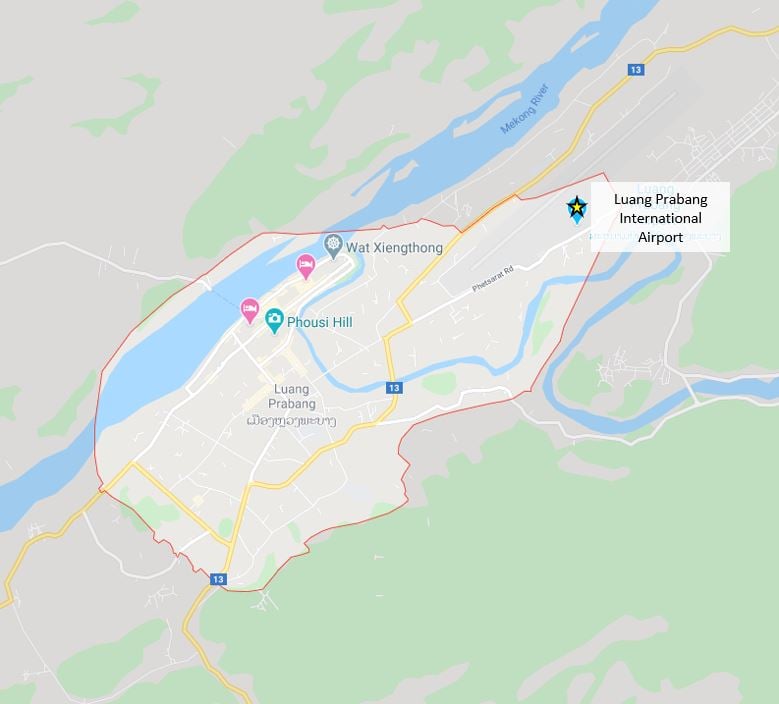
Source: Google Maps
Luang Prabang is known for its natural and historical sites that endow its tourism industry with mountains, French colonial architecture and Buddhist temples. The city center is relatively small and compact; the main modes of transportation are tuk tuks, bicycles, cars or by foot. In the heart of the city, the Royal Palace and various Buddhist temples can be found, alongside the night market that offers a variety of local eateries and crafts. Mount Phousi is also known for its sunset hike and panoramic view of the city. Outside of the city center, daytrips to Tad Se Waterfalls, and Kuang Si Waterfalls are popular among tourists to enjoy the natural beauty of the area.
UNESCO District of Luang Prabang and Demand Generators
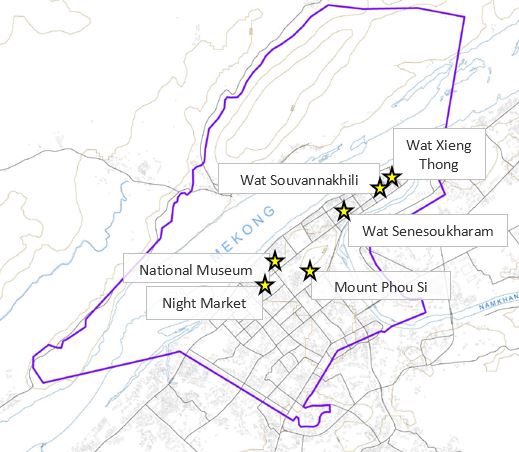
Source: UNESCO World Heritage Centre

Source: UNESCO World Heritage Centre
Luang Prabang and Mekong River
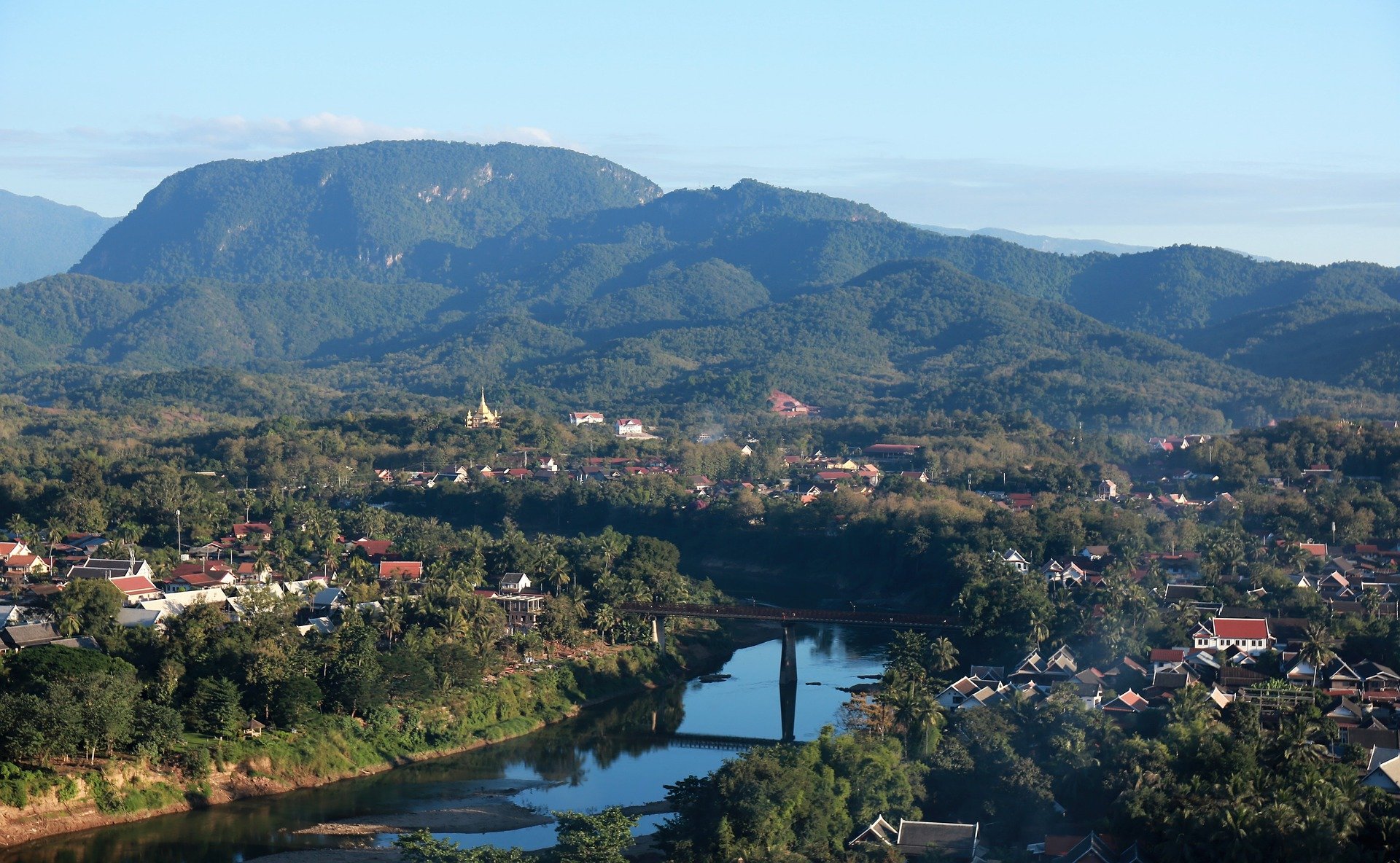

Downtown Luang Prabang
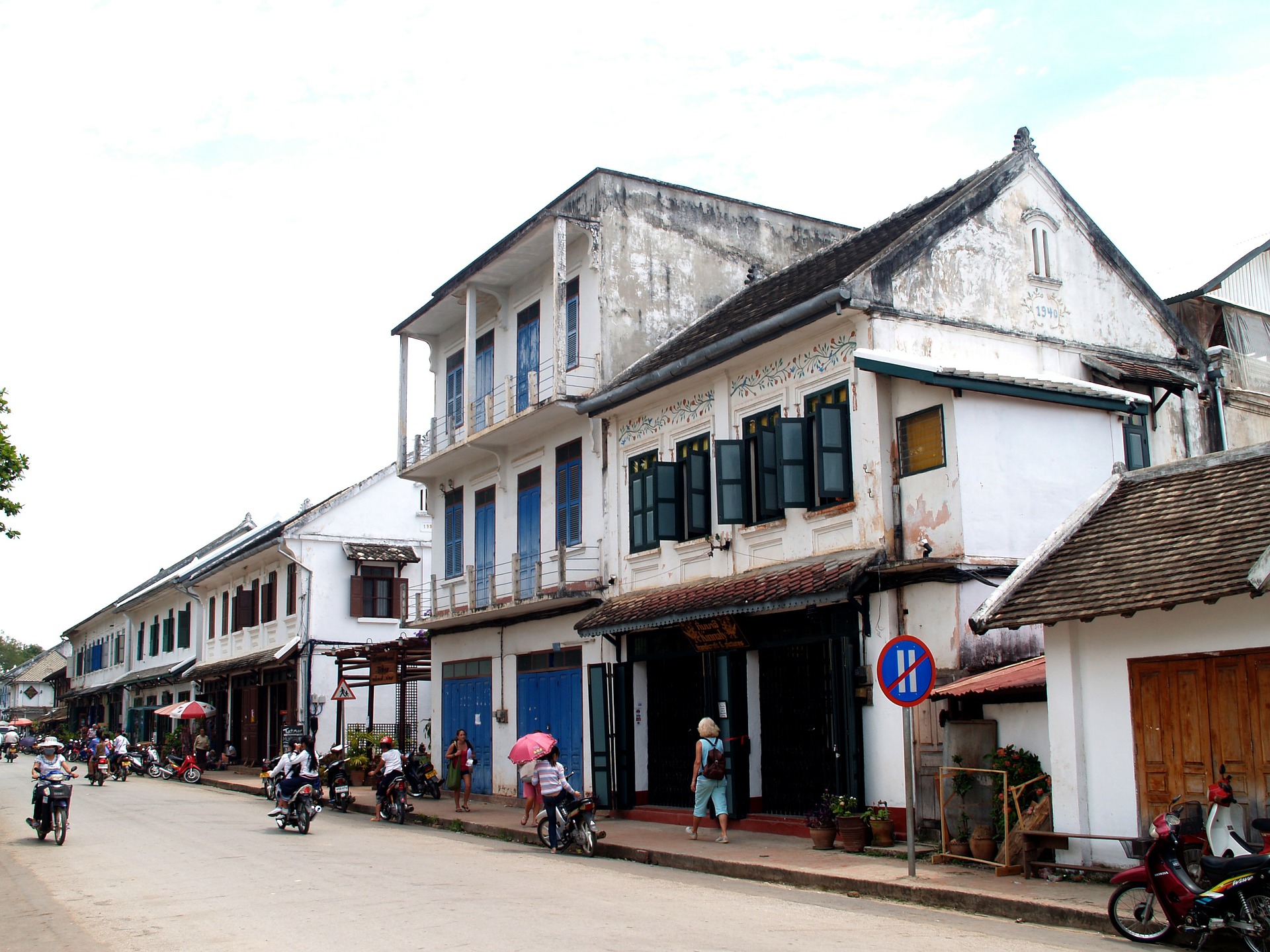

Wat Xieng Thong
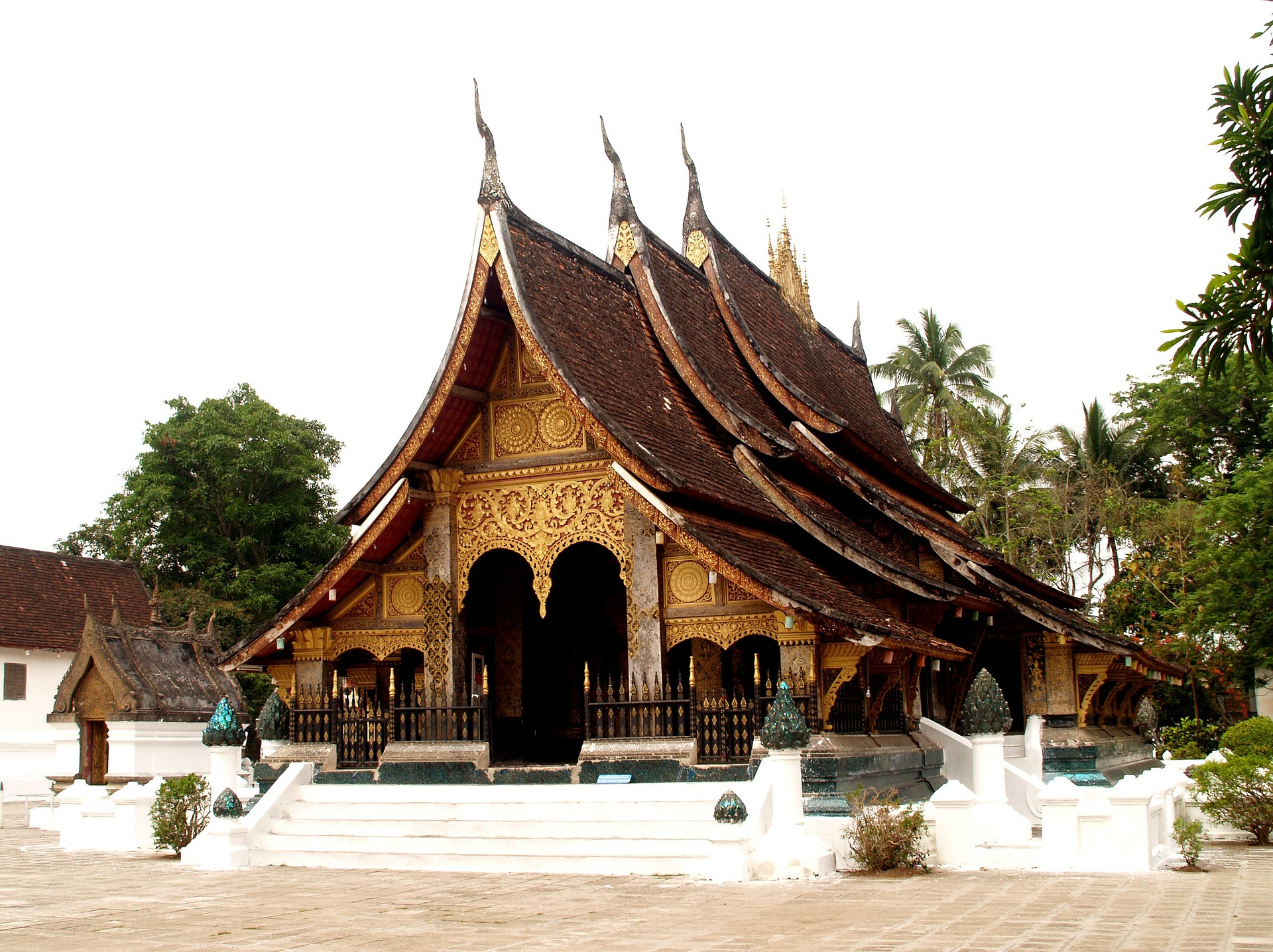

Tak Bat Ceremony
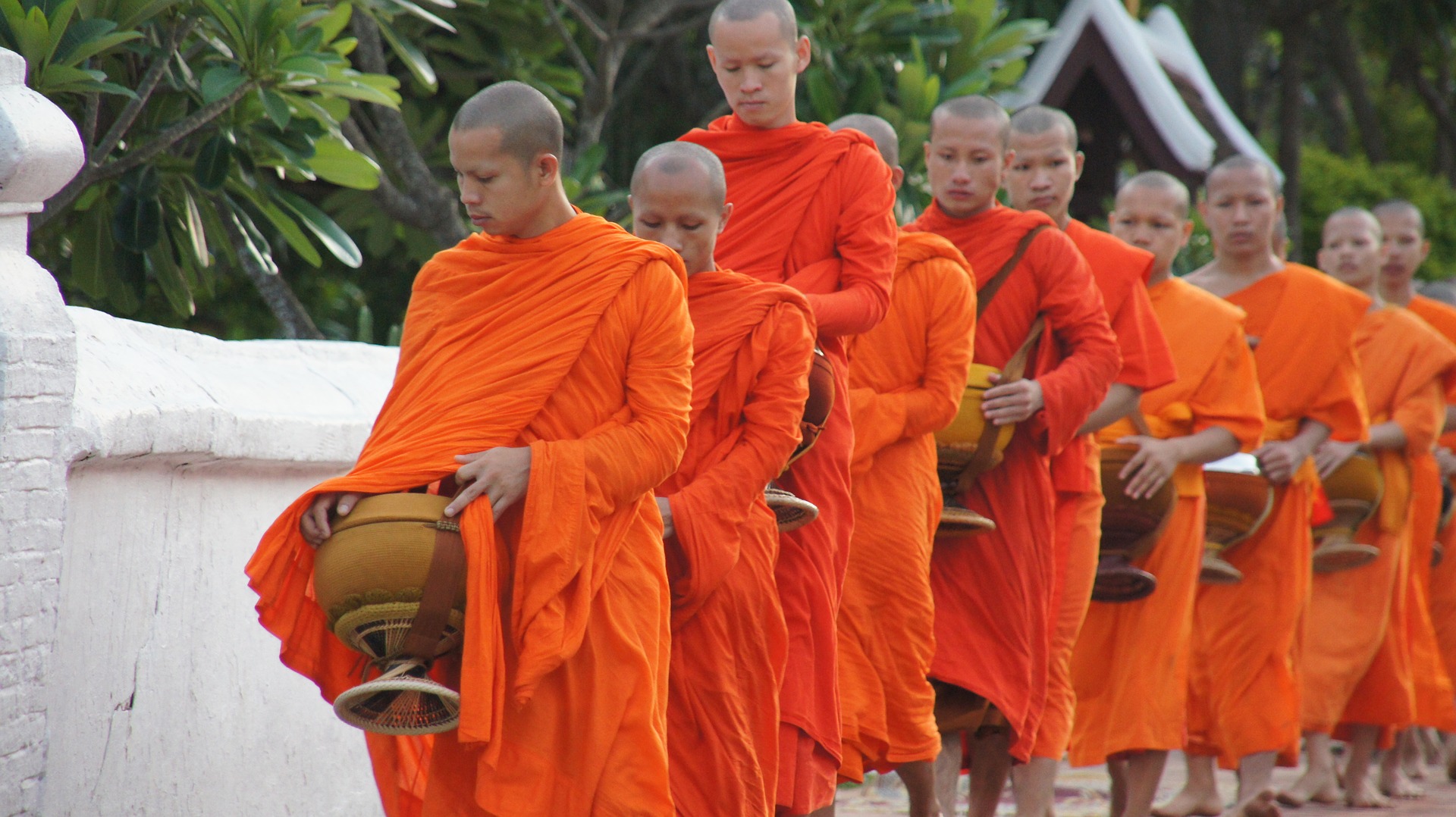
Luang Prabang is slow emerging as an up-and-coming tourist destination for South East Asia package tours, along Siem Reap (Angkor Wat), Myanmar (Old Bagan) and Vietnam (Hue). Attracting visitors with its rich history and authenticity, demand is likely to achieve moderate growth contingent on increases in air access, especially within the Greater Mekong region. Upon completion of new road infrastructure aiming to enhance connectivity between China, Thailand and Laos, there is an expectation for induced visitor demand into Laos and Luang Prabang. The related growth in visitor demand is driven by the drive-to mass market from China. Bar improvements in air access and destination marketing, Luang Prabang will continue to struggle among fierce competition from rival destinations in the region.
Source Markets
The following figure illustrates the nationality of visitor arrivals to Luang Prabang Province in 2018. The largest international feeder markets were China, Thailand and Korea, together accounting for approximately 34% of total guest arrivals. Given the unique location, the heritage appeal is gradually increasing the marketability of the destination to long-haul source markets.
Source Markets, Luang Prabang Province, 2018
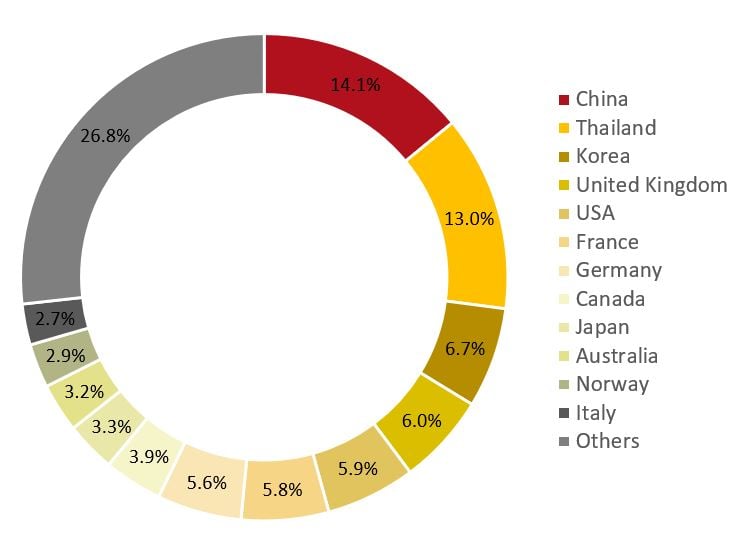
Source: Ministry of Information, Culture and Tourism, Tourism Development Department of Laos

Source: Ministry of Information, Culture and Tourism, Tourism Development Department of Laos
China alone contributes 14% of visitor arrivals and is one of the fastest growing sub-segments within the East Asia market, as a result of increased air access by charters and low-cost carriers from secondary and tertiary cities in China, as well as, land travel by car and bus. The number of Chinese arrivals to Luang Prabang from 2015 to 2018 grew by 228.9%, rising as the top feeder market among Asia and Pacific countries. Owing to Laos’ geographical positioning being bounded by China’s Yunnan Province to the northwest, many Chinese are driving to Luang Prabang from Kunming. Buses have become a popular transportation choice for Chinese tourists, which can take approximately 13 hours from Kunming.
Guest Arrivals at Accommodations
Guest Arrivals at Accommodations in Luang Prabang
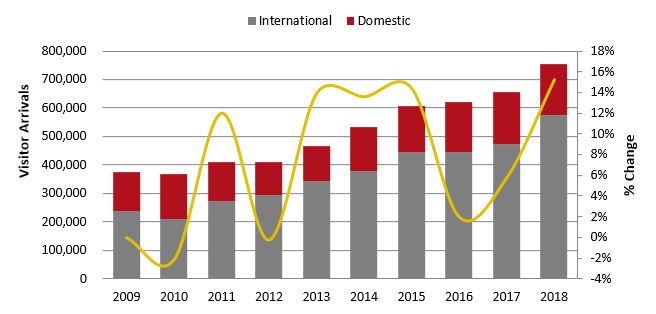

Source: Ministry of Information, Culture and Tourism, Tourism Development Department of Laos
Guest arrivals at accommodation witnessed double-digit growth in 2018, welcoming 755,019 visitors, up by 15.2% over 2017, and registered a Compound Annual Growth Rate (CAGR) of 8.1% between 2009 and 2018. From 2015 to 2018, arrivals from China to Luang Prabang increased by 228.9%, exceeding 80,000 tourists in 2018, mainly couples and families. The slowdown for foreign visitors in 2016 can be attributed to a strong marketing campaign in Thailand that encouraged people to travel within Thailand with domestic tours, as Thailand was one of Laos’ and Luang Prabang’s main feeder markets. Arrival figures regained their momentum from 2017 onward reaching an all-time high in 2018 on the back of the government tourism campaign.
Most visitors are couples and travel in small groups, as Luang Prabang hotels are smaller in size and therefore offer less child-friendly amenities for family-oriented travelers. UNESCO World Heritage Building are also subject to strict guidelines and the exteriors, internal walls and grounds may not be modified subjecting to approval from UNESCO; therefore, some buildings without elevators are not easily accessible for guests with physical disabilities.
Most visitors are couples and travel in small groups, as Luang Prabang hotels are smaller in size and therefore offer less child-friendly amenities for family-oriented travelers. UNESCO World Heritage Building are also subject to strict guidelines and the exteriors, internal walls and grounds may not be modified subjecting to approval from UNESCO; therefore, some buildings without elevators are not easily accessible for guests with physical disabilities.
Hotel Market Performance
Hotel Historical Performance, Luang Prabang, 2013-2018
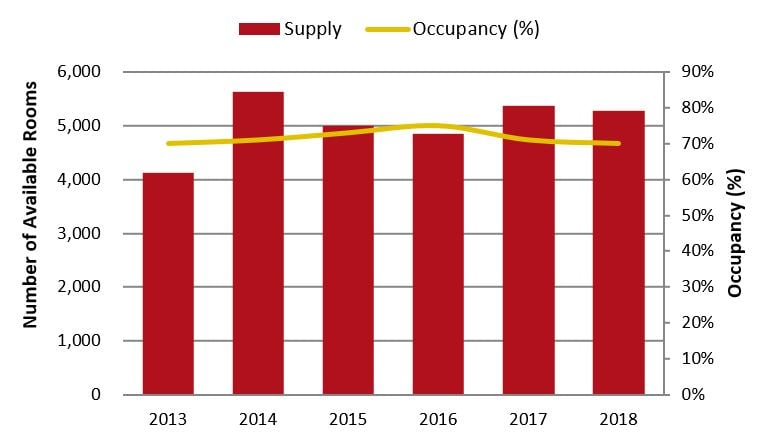

Source: Ministry of Information, Culture and Tourism, Tourism Development Department of Laos
As of 2018, hotel supply in Luang Prabang stood at roughly 5,276 rooms or 1,925,740 available room nights. Between 2013 and 2018, hotel supply showed strong growth in 2014 when multiple hotels entered the market, mirrored by a growth in visitor arrivals then. Supply registered declines after 2014, and slowly picked up in 2017 and 2018 as the Azerai Hotel opened in 2017, and Rosewood Luang Prabang in 2018. The Azerai Hotel was rebranded to Avani+ Luang Prabang Hotel in March 2018. The overall occupancy level remained relatively stable during the period from 2013 to 2018, with an average occupancy of 70.8% - the lowest being 70.0% and highest 75.0%. Lower-rated hotels typically run higher occupancy, whereas 5-star luxury hotels achieve a year-round occupancy of low-30.0% being most exposed to seasonality trends.
As Luang Prabang offers a mix of hotels from independent mid-scale to luxury, average rates vary greatly among the scale of hotels. Most accommodations in Luang Prabang are independent midscale hotels with an average rate of US$60 to US$90, targeting budget travellers. Upper Upscale hotels are positioned at an average rate of mid-US$200 to mid-US$300, whereas luxury hotels are able to achieve an average rate of mid-US$600 to over US$1,000 during peak season.
The below map shows the major branded hotels that are located in Luang Prabang downtown, with an exception of Rosewood Luang Prabang and Pullman Luang Prabang that are situated in the outskirts. While the hotels in downtown provide convenience for travelers to visit various temples all located nearby, hotels located in the suburban area offer a sense of peace and tranquility for relaxation that some travelers, particularly from Bangkok, are looking for. Overall, there remain opportunities for new resorts that can introduce innovative schemes to extend the length of stay away from a “heads-in-beds” value proposition.
As Luang Prabang offers a mix of hotels from independent mid-scale to luxury, average rates vary greatly among the scale of hotels. Most accommodations in Luang Prabang are independent midscale hotels with an average rate of US$60 to US$90, targeting budget travellers. Upper Upscale hotels are positioned at an average rate of mid-US$200 to mid-US$300, whereas luxury hotels are able to achieve an average rate of mid-US$600 to over US$1,000 during peak season.
The below map shows the major branded hotels that are located in Luang Prabang downtown, with an exception of Rosewood Luang Prabang and Pullman Luang Prabang that are situated in the outskirts. While the hotels in downtown provide convenience for travelers to visit various temples all located nearby, hotels located in the suburban area offer a sense of peace and tranquility for relaxation that some travelers, particularly from Bangkok, are looking for. Overall, there remain opportunities for new resorts that can introduce innovative schemes to extend the length of stay away from a “heads-in-beds” value proposition.
Map of Major Hotels
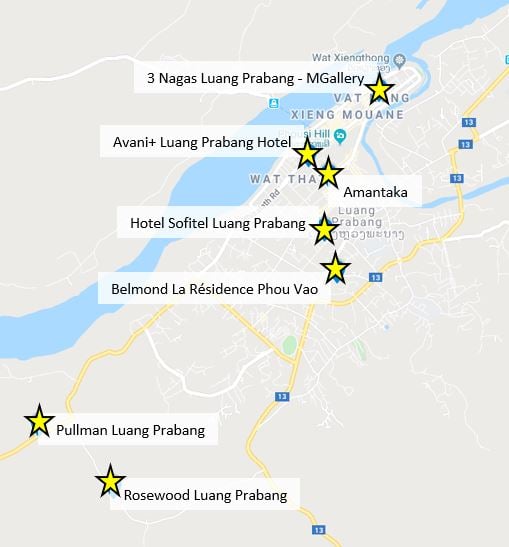

Source: Google Maps
Based on our research, in 2019, the hotel market registered a slight setback from 2018 performance due to the lack of support from the tourism board after an aggressive marketing campaign of Visit Laos Year 2018. As Rosewood Luang Prabang opened in April 2018, the market registered a decrease in occupancy and average rate in 2019 as the hotel was ramping up after its opening and took market share from other luxury hotels.
Rosewood Luang Prabang
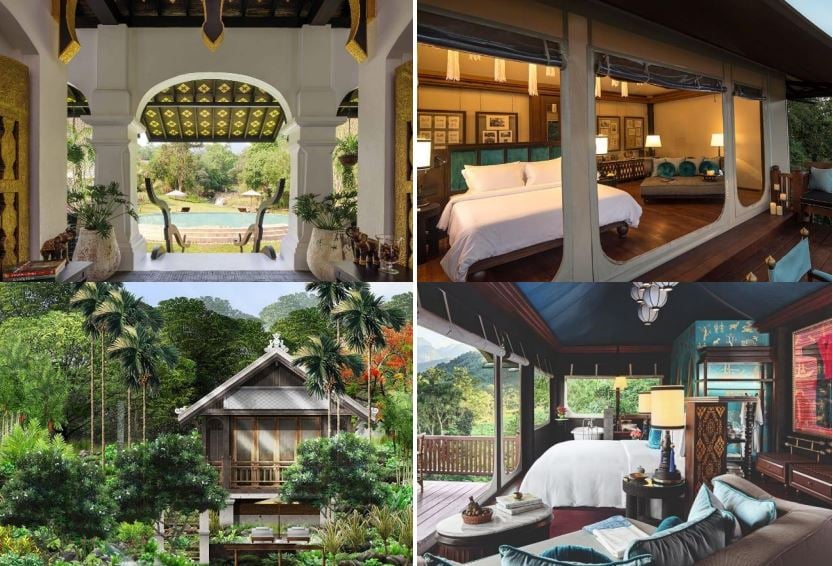

Source: Rosewood Hotels
During COVID-19 lockdown, most hotels closed at the end of March when the number of confirmed cases rose, and the country was placed in lockdown. Some hotels have resumed operations in May as domestic travel ban was lifted. Luxury hotels remain temporarily closed until September.
Hotel Supply Pipeline
After the recent opening of Rosewood Luang Prabang in 2018, the hotel pipeline in Luang Prabang remains limited with only a few international brands set to enter the market. Luang Prabang’s total room inventory is expected to remain relatively stable. Notable hotel developments are highlighted below.
Hotel Pipeline, Luang Prabang


Source: HVS Research
COVID-19 Impact and Future Outlook
The remainder of 2020 is likely to be slow and quiet for the hotel industry in Luang Prabang, as land borders remain closed. Since the first confirmed case in March, Laos underwent a nation-wide lockdown until authorities lifted domestic travel restrictions amid easing of lockdown measures in May. Due to quick government responses to the pandemic, Laos has a low confirmed case count of 19 at the time of publishing. The government announced that all tourist visas were to be suspended until further notice. Until such restrictions are lifted, the tourism sector in Luang Prabang will need to rely heavily on the domestic market in driving performance.
During this time of pandemic, many hotels were closed in Luang Prabang starting the end of March. Some midscale and upscale hotels such as Avani+ Luang Prabang Hotel and Pullman Luang Prabang resumed operations in May, as demand from domestic travelers and staycations were seen across Laos. Notably, domestic travelers tend to have a lower budget and while travel confidence slowly recovers, weekend occupancy in June achieved 30% to 40% at an average rate of US$72-100. Hotels have taken strict measures on hygiene standards to keep it a safe space for guests and employees. Some include sanitizing gels at various stations throughout the hotels, frequent cleaning and disinfection by the housekeeping team of public areas not uncommon to other hotels globally.
As luxury hotels in Luang Prabang are mainly driven by long-haul markets and international borders remain closed, Rosewood Luang Prabang and Amantaka have announced to extend their temporary closures until mid-September. These top-tier hotels are looking to achieve similar average rates in the last quarter of the year compared to 2019 with occupancy gradually ramping up to 50% by year-end in hopes that international travel will gradually recover. As the luxury hotels plan to reopen in September, there has been some demand on-the-books, especially from the European market.
Moving Forward, the hotel and tourism sector in Luang Prabang is likely to recover gradually after domestic travel restrictions were lifted. However, the full recovery will depend on the reopening of international borders. Luang Prabang has the potential to recover quicker than other markets after COVID-19 as the destination not only has very few cases of COVID-19 nationally, but still also offers rich cultural heritage in Southeast Asia with lower density and pristine outdoor scenery.
Upon completion of the Boten-Vientiane railway by late 2021, the new rail network that connects China, Thailand and Laos will attract more travelers to Luang Prabang, considering that Chinese and Thais already constitute the top two source markets. The railway will transport some passenger traffic, thus inducing demand into the country and boosting the tourism industry. However, due to COVID-19 and lockdown measures, the project timeline may be delayed.
Luang Prabang is an up-and-coming South East Asian tourist destination, offering an authentic cultural experience with preserved colonial architectures and pristine natural beauty. As a less developed country, Luang Prabang takes pride in its laid-back and less commercialized city character in comparison to its neighbors, and therefore the preservation of the city’s temples and authenticity is key to the growth of the destination. The city’s tourism industry has been a growth driver of the economy. With continued marketing efforts by the Ministry of Information, Culture and Tourism, Tourism Development Department of Laos, Luang Prabang is likely to continue to build its low-key profile as a less-developed destination in South East Asia. New flight routes with regional countries and railway infrastructures between Laos, China and Thailand will further support the continued growth of leisure travelers.
In the long term, demand from Japan is set to grow continuously over time through improved airlift, and China is projected to grow after the opening of Boten-Vientiane Railway that is scheduled to be completed in 2021 coupled with demand stimulus from Vietnam (including international tourists on regional tours). Mainland hotel brands have potential to gain more traction in Luang Prabang, in catering to Chinese travelers which is the fastest growing feeder market. However, given the distance from Luang Prabang to Vientiane, the city would be sheltered from mass marketization, where the destination gets over-crowded by tourists and becomes undesirable to travel to. In order to sustain the charm of Luang Prabang in the future, it is important that the city invests in improving infrastructures and roads to better manage demand in the city to avoid over-crowding. Religious rituals and traditions, notably the Alms Giving Ceremony in every early morning, at Luang Prabang should be carefully preserved with the initiatives from Tourism Development Department of Laos to further educate travelers, to avoid commercialization of sacred traditions. Continuous efforts to promote the destination, improve its infrastructure and overall tourism experience should be key priorities going forward.
During this time of pandemic, many hotels were closed in Luang Prabang starting the end of March. Some midscale and upscale hotels such as Avani+ Luang Prabang Hotel and Pullman Luang Prabang resumed operations in May, as demand from domestic travelers and staycations were seen across Laos. Notably, domestic travelers tend to have a lower budget and while travel confidence slowly recovers, weekend occupancy in June achieved 30% to 40% at an average rate of US$72-100. Hotels have taken strict measures on hygiene standards to keep it a safe space for guests and employees. Some include sanitizing gels at various stations throughout the hotels, frequent cleaning and disinfection by the housekeeping team of public areas not uncommon to other hotels globally.
As luxury hotels in Luang Prabang are mainly driven by long-haul markets and international borders remain closed, Rosewood Luang Prabang and Amantaka have announced to extend their temporary closures until mid-September. These top-tier hotels are looking to achieve similar average rates in the last quarter of the year compared to 2019 with occupancy gradually ramping up to 50% by year-end in hopes that international travel will gradually recover. As the luxury hotels plan to reopen in September, there has been some demand on-the-books, especially from the European market.
Moving Forward, the hotel and tourism sector in Luang Prabang is likely to recover gradually after domestic travel restrictions were lifted. However, the full recovery will depend on the reopening of international borders. Luang Prabang has the potential to recover quicker than other markets after COVID-19 as the destination not only has very few cases of COVID-19 nationally, but still also offers rich cultural heritage in Southeast Asia with lower density and pristine outdoor scenery.
Upon completion of the Boten-Vientiane railway by late 2021, the new rail network that connects China, Thailand and Laos will attract more travelers to Luang Prabang, considering that Chinese and Thais already constitute the top two source markets. The railway will transport some passenger traffic, thus inducing demand into the country and boosting the tourism industry. However, due to COVID-19 and lockdown measures, the project timeline may be delayed.
Luang Prabang is an up-and-coming South East Asian tourist destination, offering an authentic cultural experience with preserved colonial architectures and pristine natural beauty. As a less developed country, Luang Prabang takes pride in its laid-back and less commercialized city character in comparison to its neighbors, and therefore the preservation of the city’s temples and authenticity is key to the growth of the destination. The city’s tourism industry has been a growth driver of the economy. With continued marketing efforts by the Ministry of Information, Culture and Tourism, Tourism Development Department of Laos, Luang Prabang is likely to continue to build its low-key profile as a less-developed destination in South East Asia. New flight routes with regional countries and railway infrastructures between Laos, China and Thailand will further support the continued growth of leisure travelers.
In the long term, demand from Japan is set to grow continuously over time through improved airlift, and China is projected to grow after the opening of Boten-Vientiane Railway that is scheduled to be completed in 2021 coupled with demand stimulus from Vietnam (including international tourists on regional tours). Mainland hotel brands have potential to gain more traction in Luang Prabang, in catering to Chinese travelers which is the fastest growing feeder market. However, given the distance from Luang Prabang to Vientiane, the city would be sheltered from mass marketization, where the destination gets over-crowded by tourists and becomes undesirable to travel to. In order to sustain the charm of Luang Prabang in the future, it is important that the city invests in improving infrastructures and roads to better manage demand in the city to avoid over-crowding. Religious rituals and traditions, notably the Alms Giving Ceremony in every early morning, at Luang Prabang should be carefully preserved with the initiatives from Tourism Development Department of Laos to further educate travelers, to avoid commercialization of sacred traditions. Continuous efforts to promote the destination, improve its infrastructure and overall tourism experience should be key priorities going forward.

0 Comments
Success
It will be displayed once approved by an administrator.
Thank you.
Error